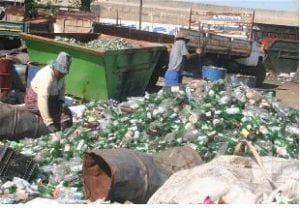The possible impact of the current definition of waste in the Waste Act on job creation, the national climate change response strategy, innovation and international trade barriers was the topic of a briefing of the Parliamentary Portfolio Committee on Environment, by Dr Dhiraj Rama, executive director of the Association of Cementitious Material Producers.
The current definitions in the Act do not provide clarity as towhen a material becomes and when waste ceases to be waste. The Act recognises only reuse, recycling and recovery as acceptable treatment processes to end waste status. Cleaner production and associated technology interventions are not considered. There is thus no allowance for possible new emerging technologies or innovation that does not fall within the scope of re use, recycle or recover. The definitions has thus resulted in waste permitting requirements becoming necessary for substances that otherwise are handled as products in other countries. This has far reaching consequences to generators, transporters, and consumers. He described international practices, including the pragmatic European Union approach which provides guidance to when a material or object assumes waste status and when a waste ceases to be waste. Details of these are included in the European Waste Directive. In the EU Waste Directive important definitions such as byproduct, recoveryand prevention have been included. The definition of prevention was specifically highlighted and quoted as follows: ‘Prevention means measures taken before a substance, material or product has become waste that reduce:(a) the quantity of waste, including through the re-use of products or the extension of the life span of products;
(b) the adverse impacts of the generated waste on the environment and human health; or the content of harmful substances in materials and products’ The description of the by product and recovery definitions are also noteworthy as it provides unambiguous clarity on material status. In the UK, the Waste and Resources Action Programme (WRAP) of the Government Environment Agency continually produces Quality Protocols for a wide range of waste materials. These define how ‘waste’ can be turned into a saleable product on the open market. The methodology involves innovative approaches by hosting multiple consultations and is sector based. Conventional waste streams, ranging from vegetable oil to pulverised fuel ash, go to landfill even though they can be re-used or recycled because of the difficulty in selling them on, once they are classified as waste. The protocols entail an elegant, simple approach. Many of these materialsare considered to be by-products rather than waste as informed by various criteria. The following demonstrates some of the criteria included:
• The material is certain to be used;
• No further processing is required for use; and
• The material is used as an integral part of the continuing production process.
Application of these protocols have resulted in materials such as blast furnace slag, pulverised flue ash, bottom ash and elected biomass, composting and agriculture streams being declared by-products and not waste.
In the USA, the concept of ‘co-product’ has been introduced, if the use of the material presents no greater threat or harm to human health and the environment than the use of the product or raw material. In Australia, the approach taken entails the inclusion of the following definition to clarify waste status:Ready and intended for imminent use: Waste will remain waste until it can be demonstrated that it constitutes a product that is ready and intended for imminent use without the need for further treatment to prevent any environmental harm. In South Africa, the Act has included the scope for a beneficial use approach to waste. However, as is the case with the definitions, the approach is quite restrictive and does not yield end of waste status to the resources identified. Dr. Rama cautioned that defining many such by-products as waste could have major impacts on the government’s greening the economy projects, job creation, climate change mitigation strategies, and administrative costs to small enterprises. An immediate example that comes to mind would be the use of biomass as an energy source. There are already international publications confirming that misdirecteddefinitions of waste are stifling the growth of this sector. In his opinion, there is already a robust Environmental Impact Assessment (EIA) regulatory requirement in place to ensure that environmental best practice is adopted by the different sectors. Classifying many of these materials as waste would not protect or improve the environment, while declaring these materials as by-products wouldimprove efficiency in the way the products are used in terms of the hierarchy of waste principles by avoiding unnecessary financial and administrative burden. Furthermore, amendments to the Waste Act would harmonise our approach to environmental management and international trans-boundary movement. This would also support our country’s sustainable development initiatives as well as contribute to our international commitments to reducing greenhouse gas emissions. It is important that the Department facilitate commerce by reviewing the Waste Act. Much of the regulatory administrative burden, particularly on emerging enterprises, would be avoided without compromising the environment.









